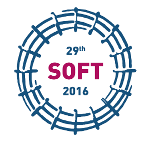Speaker
Yuefeng Qiu
(Karlsruhe Institute of Technology)
Description
The location of the lithium quench tank (QT) is an important safety related issue in the design of the test cell (TC) of the IFMIF-DONES (International Fusion Material Irradiation Facility- DEMO Oriented Neutron Source). In the current reference design, the QT is situated outside the TC and is connected to the target assembly through a long lithium outlet channel penetrating the TC floor. Compared to the option with the QT located inside the TC, this configuration significantly reduces the activation of the QT and the tritium production. However, the long lithium channel may cause instabilities of the lithium flow and will result in a strong neutron streaming through the channel into the lithium systems room beneath the TC floor. Another recent proposal considered to locate only the upper half of the QT inside the TC while the lower half is embedded in the TC floor which is then reinforced with additional shielding. Such a configuration would have both advantages and disadvantages which need to be evaluated on the basis of a dedicated analysis.
In this work, neutronics analyses are carried out to assess both options of the TC locations in IFMIF-DONES. The McDeLicious-11 code, which is an extension to the MCNP5-1.6 Monte Carlo code with the capability to simulate the deuterium-lithium neutron source in IFMIF-DONES, is employed in the calculations. The neutron flux distribution, the tritium production rate and the dose rate distribution during operation are evaluated and compared. In addition, the shut-down gamma dose rate distribution in the lithium systems room is calculated. This is of great concern for maintenance operations scheduled for the lithium-loop facilities. The shut-down dose rate calculations are carried out by using the R2Smesh code system developed at KIT. Based on the results of these analyses suggestions are made for the QT arrangement in IFMIF-DONES.
Co-authors
Frederik Arbeiter
(Karlsruhe Institute of Technology, 76344, Eggenstein-Leopoldshafen, Germany)
Friedrich Groschel
(Karlsruhe Institute of Technology, 76344, Eggenstein-Leopoldshafen, Germany)
Kuo Tian
(Karlsruhe Institute of Technology, 76344, Eggenstein-Leopoldshafen, Germany)
Ulrich Fischer
(Karlsruhe Institute of Technology, 76344, Eggenstein-Leopoldshafen, Germany)
Yuefeng Qiu
(Karlsruhe Institute of Technology, 76344, Eggenstein-Leopoldshafen, Germany)

